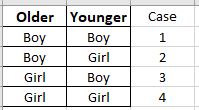Tags
Some probability situations are quite confusing!
There is a pretty well-known paradox which goes something like this:
You hear that the Smith and Jones families each have two children.
You are told that the older Smith child is a girl, and that at least one of the Jones children is a girl.
Assuming that boys and girls are equally likely to be born (I know this is not quite true, but let’s pretend) in any given pregnancy, what are the chances that the Smiths have two girls? How about the Joneses?
Most people would say that those probabilities are equal: 50% in both cases.
But they are not. In fact, it is much less likely that the Joneses have two daughters!
Here is why:
In any family with two children, there is an older sibling and a younger one.
In the Smith family, you know that the older child is a girl, but you know nothing about their younger child, so the younger one is equally likely to be male or female. So the chances that the Smiths have two daughters is indeed 1/2, or 50%.
In the Jones family, all we know is that there is at least one girl. Let’s look at a diagram that shows all of the equally-likely possibilities in any family with two children:
With the Smith family, we can rule out cases 1 and 2, leaving us cases 3 and 4.
However, with the Jones family, we can only rule out case number 1. Cases 2, 3, and 4 — which are all equally likely — are all possible outcomes for the Joneses. Notice that only in case number 4 do the Jones have two daughters. So with the Joneses, the chances that there are two daughters is only 1 in 3, or 33.3%.
And that result is a lot lower than 50%!
Weird, right?


The answer to “What is the probability that a two-child family has two girls, given that they have at least one girl?” is 1/3.
The answer to “You hear that the … Jones [family has] two children … and that at least one of the Jones children is a girl. What are the chances that the [Jones] have two girls?” is 1/2.
The difference is that in the first question, all GG, GB, and BG families are implied by the word “given.” In the second, it is equally likely that “you will hear” that a BG or GB family has a boy, or that they have a girl. You can only count half of them.
Don’t believe me? This problem originated in the May, 1959 issue of Scientific American, in the “Mathematical Games” column by Martin Gardner. (Well, the Smiths had at least one boy, and the Jones’ older was a girl, but the concepts were the same.) Gardner originally said the answer was 1/3, but in October he retracted it.
LikeLike